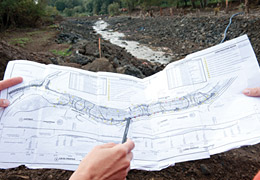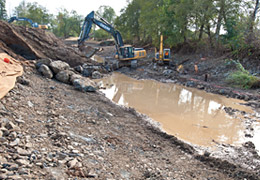The Long Memory of Small Dams

One hundred and fifty years ago the town of Brownsville, in western Oregon, built a small dam to divert water to local woolen and lumber mills.
The Brownsville Dam was soon joined by two more dams—Sodom and Shearer—built to divert water to a local grain mill. The dams became part of the region’s landscape where they helped develop commerce and community.
However, as the reality of a competitive world market set in, the mills eventually closed. The dams became maintenance liabilities, as well as barriers to fish passage and factors in the ongoing degradation of the river channel. The impact of the dams on water flow was so severe and the diversions so effective that the main channel of the Calapooia River was at risk of running dry. Something needed to be done.
Although the details of these three dams were specific to the Calapooia, the general problem of aging and failing dams was becoming a much larger issue. Across the United States, more than 2.5 million dams obstruct waterways. They range from small structures a few feet tall designed primarily for irrigation to 600-foot structures capable of powering cities.

- Detailed construction plan for the Sodom dam removal and restoration project on the Calapooia River. Photo by Lynn Ketchum.
At the time of construction, most of these dams were seen as beneficial for flood control, clean energy generation, irrigation and drinking water supply, and recreation, says Desiree Tullos, an associate professor in OSU’s Department of Biological and Ecological Engineering. Yet, as time and science progressed, problems associated with the dams became apparent. Fish populations, river channel stability, and instream-flow patterns all experienced declines where dams were present, and as the structures aged, concerns for public safety arose.
Today about 90 percent of Oregon’s small dams, of which there are more than 3,500, are more than half a century old and are near or beyond the end of the 50-year licensing period granted by the Federal Energy Regulatory Commission, the group that governs the nation’s hydropower projects, says Tullos. Retrofitting or removing these dams is increasingly on water managers’ To-Do lists, as was the case in the Calapooia watershed back in the early 2000s.
“The Calapooia Watershed Council and community stakeholders realized very early that the status quo was not an option,” says Denise Hoffert-Hay, Calapooia Watershed Council project manager for dam removal. The group moved relatively rapidly from thinking about improving the dams for fish passage to planning for the full-scale removal of the Brownsville, Sodom, and Shearer dams, says Hoffert-Hay. Removal would lead the way toward restoring a free flowing river and opening new spawning grounds and habitat to endemic populations of winter steelhead and spring Chinook, which are both listed as threatened under the Federal Endangered Species Act.
The Brownsville Dam was removed in 2007; next was the removal of Sodom and Shearer in 2011. Tullos and her team were there to document the process.

- Desiree Tullos, an ecological engineer at OSU, studies the impact of dams—and their removal—here on the Calapooia watershed and around the world. Photo by Lynn Ketchum.
“Dam removal is a relatively new step in river restoration and management,” says Tullos. “It’s becoming increasingly common, but how different rivers respond in the aftermath is still a large unknown. Working with the Calapooia Watershed Council to study the system before and after removal has given us invaluable information that will inform future management decisions on other rivers around the world.”
Because of the monitoring work done by the OSU team on the Calapooia, one long-standing assumption of dam removal—that it will have a large and immediate impact on the river bottom and overall water quality—has proven largely false.
Large deposits of sediment accumulate behind dams where they are incapable of washing downstream and spreading naturally throughout the river channel. Dam removal unmoors these accumulated deposits in a “pulse” that is important for rebuilding habitat but can be difficult to predict. How this pulse will affect downstream habitat and water quality has been a primary concern in dam removal, says Tullos. Yet, on the Calapooia, the pulse of sediment has had minimal impact.
“We saw some channel reorganization following the dam removal, but the overall effects on the physical ecosystem have been minimal and difficult to detect,” says Tullos. “In some areas, habitat complexity increased rather than decreased by the deposition of coarse sediment released from behind the dam. The Calapooia is showing us that concerns over sediment pulses with small dam removals in the Pacific Northwest may be often unfounded.”

- Heavy equipment removes the last vestiges of the dam; however, it might take longer for some fish species to move past their sense of a phantom dam. Photo by Lynn Ketchum.
The Calapooia has been a managed river since the 1800s, and it is unrealistic to expect immediate recovery to a natural state, says Hoffert-Hay. Restoration in this system does not mean returning the river to its non-altered condition. Rather it means changing the management plan of the river to achieve different goals, such as improved fish passage and sediment transport.
“If stakeholders in the Calapooia watershed had not opted to remove the Sodom and Shearer dams, the historic Calapooia River channel likely would have become a backwater without year-round flow,” says Hoffert-Hay.
It is likely the Calapooia channel will recover relatively quickly with proper management. However, the influence of removal on the native fish populations is not as immediate, or as clear. “Removal has never been a guaranteed quick fix for the restoration of fish populations,” Tullos says. “It is, however, an opportunity for species and habitat recovery that otherwise might not exist.”
Tullos has first-hand experience with fish recovery following dam removal. In 2008, she monitored channel and ecological changes related to the removal of the Chiloquin Dam on the Sprague River in southern Oregon. There, the fish species of concern were the endangered Lost River and short nose sucker.
Before the dam was removed these fish would often get stuck at the structure, unable to pass upstream to spawn. It made sense to believe that removing the structure would open new habitat and allow fish an easier passage up and down the river, says Eric Janney, a fisheries biologist for U.S. Geological Survey Klamath Falls field station. There was some surprise when, more than four years after the dam was removed, less than ten percent of the fish migrating up the Sprague were continuing past the old dam site. It’s as if the dam had a phantom-limb effect on the long-lived suckers.
“The lack of upstream migration may be related to the population’s fidelity to their spawning grounds,” says Janney. “It could take a number of years before we see suckers regularly migrating upstream past the old dam site.”

- The Calapooia River was at risk of losing its historic channel before the aging dams were removed and the flow restored. Photo by Lynn Ketchum.
This lag is also expected for salmon and steelhead on the Calapooia. “We won’t expect to see a bounce in recovery of fish in the near term on the Calapooia,” says Hoffert-Hay. “For the native steelhead population it will take at least one ocean cycle and likely several to realize any change. The Chinook are even more sensitive, and we anticipate a long wait before seeing quantifiable improvements in the number of returns.”
The Calapooia and Chiloquin studies suggest that while negative impacts of dam removal on the physical river channel may be less than previously assumed, the impact of dam construction on aquatic life and fish populations may be longer lasting, particularly given stresses beyond the river that migrating fish face, says Tullos. For communities contemplating construction of future dams, these are important lessons to consider.
